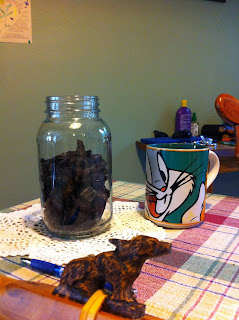We have a
little overnight expedition coming up this weekend with a small select group.
With these
summertime temperatures and high humidity steaming our region, I figure the
least amount of time necessary cooking over an open fire is a wise investment
of time. Do some prepping. Keep it simple. Keep it fast.
Deer jerky
is one of the food items that will accompany us on this hike and overnight on the Perdido River.
I’m not a
fan of the commercially processed jerky that can be picked up at practically
every corner store. I’m also not a fan of the packets of stuff that can be
bought and used in making jerky at home. The stuff is packed full of ingredients
that I can’t pronounce.
Commercially
processed jerky, to my taste, doesn’t taste like meat. It tastes like all the
stuff added to the meat.
I’m also not
a fan of using purchased beef to make jerky.
Think about
it.
Jerky is raw meat that has been dried at a slightly warm temperature. Being raw and dried means none of the nutritional value has been destroyed by
high cooking temperatures that also destroys pathogens.
If I am
going to eat raw meat it is going to
be meat that I’ve killed and processed. Not something that was killed and
processed by who knows who, who knows where, then hauled across the country to
be handled again by who knows who at who knows where. I’m a little squirrelly about stuff like that and
growing more squirrelly with the
reoccurring outbreaks of serious foodborne
illnesses … illnesses that can do you a lot worse than give you a bad case
of the trots.
The
particular cut of deer in the first picture comes from the hindquarter. There’s
one of these on each hindquarter. It has a number of sections to it that are
separated by layers of sinew. It’s a bit of careful work with a sharp blade to
turn it into clean bite sized pieces for jerky but I have discovered this cut
to be one of the most tender parts of a deer and well worth the time invested.
What do I
use on the deer meat to season it?
Whatever
happens to be handy in the house.
The marinade
for this batch has only a few items in it … Dale’s
Seasoning, Liquid Smoke, a little salt, a little black pepper, and a couple tablespoons of honey.
Enough of each
to flavor the meat without disguising the taste of the meat.
 I prefer to
let my jerky marinate in the refrigerator for a few hours before loading it to
the dehydrator. The step isn’t absolutely necessary. It’s just a personal
preference after making my own jerky for a while.
I prefer to
let my jerky marinate in the refrigerator for a few hours before loading it to
the dehydrator. The step isn’t absolutely necessary. It’s just a personal
preference after making my own jerky for a while.
I cut these
bite sized pieces about 3/8ths of an inch thick. ¼ inch or thinner dehydrates
faster if you are pressed for time. This batch … at this thickness … on our
dehydrator … took better than 24 hours to finish.
There’s a
lot of tasty woods goat nutrition in that jar that’s good “as is” or it can be
added to the bush pot with a measure of dehydrated vegetables, rice, and
whatever your preferential seasonings are to make a really fine stew.


No comments:
Post a Comment